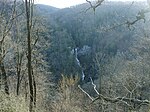Civilian Conservation Corps Quarry No. 2
Buildings and structures in Pickens County, South CarolinaCivilian Conservation Corps in South CarolinaNational Register of Historic Places in Pickens County, South CarolinaNational Register of Historic Places in South CarolinaPickens, South Carolina ... and 3 more
Quarries in the United StatesUpstate South Carolina Registered Historic Place stubsUse mdy dates from August 2023

Civilian Conservation Corps Quarry No. 2 is a historic Civilian Conservation Corps (CCC) quarry site located near Pickens, Pickens County, South Carolina. The site is associated with the CCC construction of Table Rock State Park between 1935 and 1941. It is one of four quarry sites used for materials in the construction of park structures and facilities at the park. Located on the property is a concrete spring house built by CCC workers.It was listed on the National Register of Historic Places in 1989.
Excerpt from the Wikipedia article Civilian Conservation Corps Quarry No. 2 (License: CC BY-SA 3.0, Authors, Images).Civilian Conservation Corps Quarry No. 2
Blue Hills Trail,
Geographical coordinates (GPS) Address Nearby Places Show on map
Geographical coordinates (GPS)
| Latitude | Longitude |
|---|---|
| N 35.005833333333 ° | E -82.721666666667 ° |
Address
Blue Hills Trail 134
29671
South Carolina, United States
Open on Google Maps






